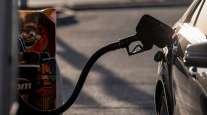Senior Reporter
As Harvey Rages in Texas, Diesel Starts to Climb

The U.S. average retail price of diesel rose 0.9 cent to $2.605 a gallon, inching past the $2.60 mark for the first time in more than two years after Tropical Storm Harvey’s fierce winds and record rainfall battered oil production and fuel refineries along the Texas Gulf Coast.
Harvey initially came ashore as a Category 4 hurricane in Texas on Aug. 25, then went back out to sea and lingered off the coast as a tropical storm for days, inundating flood-prone Houston. The five straight days of rain totaled close to 52 inches, the heaviest tropical downpour ever recorded in the continental United States.
A government survey of fuel prices resulted in diesel’s highest price since Aug. 17, 2015, when it was $2.615.
Diesel costs 19.6 cents more than it did a year ago, when it was $2.409 a gallon, the Department of Energy said Aug. 28.
Prices for trucking’s main fuel climbed in all regions except the Midwest, where it fell by 0.1 cent.
HARVEY'S IMPACT: Oil, gas prices and overall economy to be affected
TRUCKER RESCUED: Driver pulled from his cab as floodwaters rise on Beltway 8
VOLUNTEERS JUMP IN: Fleets saved the stranded, delivery supplies by boat
Meanwhile, the U.S. average price for regular gasoline jumped 3.9 cents to $2.399 a gallon. The cost is 16.2 cents more than it was a year ago, DOE’s Energy Information Administration said.
Weekly gasoline prices rose in all regions, EIA said.
West Texas Intermediate crude futures on the New York Mercantile Exchange closed at $46.57 on Aug. 28 compared with $47.37 per barrel Aug. 21.
Harvey shut down refining capacity by an estimated 4.1 million barrels a day due to flooding and port closures as of Aug. 29, according to Goldman Sachs Group Inc., representing 23% of U.S. refining production.
But Jeffery Born, a finance professor at Northeastern University in Boston, told Transport Topics that as of Aug. 30, as Harvey’s projected path was taking it into the refining areas of Louisiana, about 15% of the nation’s refining capacity was off-line.
“[Harvey] could disrupt even more refining capacity. Informed estimates suggest that refining capacity around the Texas Gulf Coast will be off-line for at least a week,” he said.
At the same time, Colonial Pipeline’s system continued to operate at a reduced capacity due to “limited supply from Houston-area origins, and storm related damage at our Pasadena, Houston and Cedar Bayou facilities,” the company reported Aug. 29.
The 5,500-mile pipeline network transports fuel from Gulf Coast refineries throughout the South and eastern United States, according to Colonial.
Analysts speculated on how expensive diesel would become.
“Crude calculations, which is all I can muster, and a comparison to Katrina, which is the best we have available, show that diesel prices could increase as much as 25%, or about 60 cents a gallon,” depending on how much damage, if any, was done to the refineries, which may take several more days to know, FTR Chief Operating Officer Jonathan Starks told TT on Aug. 30.
“After Katrina, the biggest hit [on diesel prices] didn’t actually occur until October and then quickly reverted to normal,” Starks added. Katrina struck southeast Louisiana on Aug. 29, 2005.
“Katrina had significant impacts on numerous infrastructure, including pipeline. Harvey isn’t expected to pose quite a significant risk in that regard, but only time will tell,” he said.
Born said spikes in gasoline and diesel prices were likely.
“To date, the impact of Harvey on diesel has been more muted compared with gasoline; that is about to change. I would say over the next two to three weeks we are likely to see price increases in excess of a dime, maybe as much as a 25 cents a gallon, if the refining capacity doesn’t come back online in a week,” he said. “Remember, there is a huge incentive for firms to get production back online ASAP; they can ‘catch the wave’ in upward prices if they beat their competitors back to the marketplace.”
When Harvey first made landfall, truck stop chains scrambled to continue services in the area.
“Some fuel loading racks are down due to the storm,” Love’s Travel Stops & Country Stores spokeswoman Kealey Dorian told TT on Aug. 28. “We have brought in trucks from other areas of the country to help haul fuel from other racks in Texas to the affected areas. Our logistics team is working diligently to locate fuel and take it to the necessary locations.”
Another truck stop operator also reported Aug. 28 that some locations were under a tornado warning.
“We are getting back in operation, but roads are still under water and that is impeding both some employees and certainly customers from reaching our locations,” TravelCenters of America spokesman Tom Liutkus told TT. TA and Petro Stopping Centers are TravelCenters of America brands.
The Pilot Flying J chain reported Aug. 28 its stations remained open “as conditions permitted,” and its support center emergency response team continued to monitor conditions, coordinate operations and provide 24-hour support.




